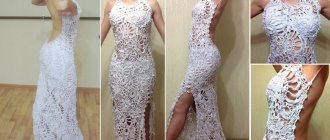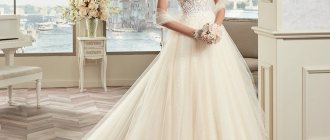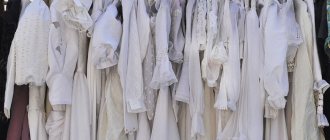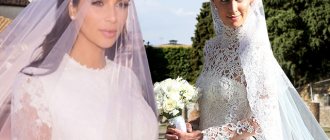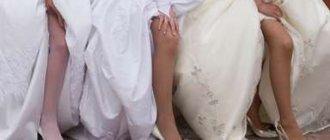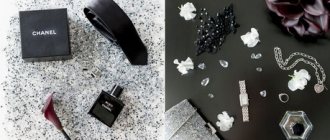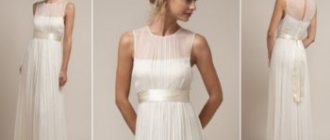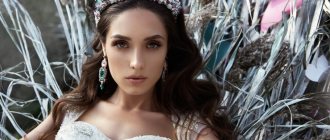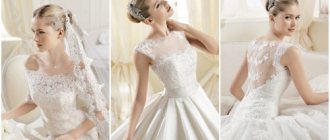For a woman, a wedding dress is perhaps the most long-awaited outfit. Century after century replace each other, our life and fashion change, but, as always, the next happy bride reverently touches her wedding dress, as if it were the most amazing and most beautiful outfit. A woman remains a woman and dreams of getting married in any era.
Photo courtesy of the Valencia wedding salon
Today it’s hard to believe, but as such, a wedding or wedding dress did not exist until the mid-19th century. The bride appeared in the best clothes she had.
Why does a wedding dress have a soul?
An inexhaustible source of inspiration for wedding style is the people. As you know, each ethnic nation is unique, distinguished by its own traditions and religion. Therefore, the bride’s robes in ancient times were deeply symbolic and carried an inextricable spiritual connection between generations.

Photo courtesy of the Valencia wedding salon
One can only superficially trace the moments of the canonical formation of wedding fashion. It is almost impossible to retell a story as long as the journey of humanity. Only echoes of those times have reached us, from which we can judge how our distant fellow tribesmen dressed for a wedding.
White dress in ancient times
Let's delve into history and remember Ancient Greece with its sophistication and love of beauty.
White was the color of sacrifice to the gods; a black lamb was never laid on the altar; it was white that was considered by the Hellenes a symbol of humility and worship. And we should be grateful to the ancient Greeks for the ritual of exchanging rings during marriage. In ancient times, prisoners were led to the scaffold in white. White color did not attract women because of its simplicity; a wedding was supposed to be a grandiose spectacle with an abundance of colors and shine. However, over time, due to witch hunts and frequent executions in public squares, the color red became associated with the executioner's robe and ceased to be a wedding attribute.
By the middle of the 17th century, the white dress suddenly became mourning. In those days, dowager queens began to dress up in completely white dresses, they were even nicknamed “White Ladies.” According to the first legend, Mary Stuart wore a white wedding dress in memory of her dead husband.
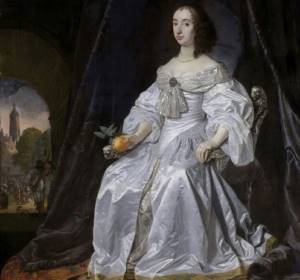
All of Europe was shocked by this act, but soon, more and more noble ladies began to walk down the aisle in white robes.
History starting points
Antique era
Ancient Greek and Roman brides dressed up using long, light-colored fabric, fastened on the chest, back or side with special clasps. A wreath of laurel leaves symbolized the triumph of youth and beauty. Sometimes it was replaced with a gold-colored cape. Strict and simple lines were inherent in ancient harmony.
Ancient Egypt
It was there that the first legal marriages took place and marriage contracts appeared. How can the homeland of family ties do without a wedding dress? It became mandatory for ancient Egyptian women almost for the first time. The Kalasiris (bride's wedding dress) was similar to the ancient one. White fabric, embroidered with gold and precious stones, hugged the body from chest to ankles and was held in place by a strap.
The ascetic background accentuated the decorations. Countless amulets and amulets in the form of pendants, rings, bracelets, belts, tiaras had a deeply sacred meaning, as they were a piece of faith. They connected the newlywed with divine powers, protecting her from evil spirits and damage. Popular green jewelry symbolized fertility.
Ancient Rome
He did not want to flaunt the natural charms of his women, cultivating modesty and chastity. Earthly beauty is a sin, so the Romans believed and hid it under the folds of a fiery yellow, like the sun, wedding blanket “flamenium”. The ceremonial decoration personified the source of vitality and light. Clothes were removed only when the newlyweds were alone. In many ways, the Romans adopted the culture of dressing in clothes from the Greeks.
The troubled pre-medieval period was darkened not only by the fall of the Roman Empire, but also by the oblivion of the cult of the beauty of the human body. Byzantine brides shyly hid under double, shapeless tunics embroidered with gold and pearls. It was allowed to cast casual glances only at the expensive heavy fabrics from which multi-layered outfits were sewn.
Socialite
The first wedding dresses, familiar to us, appeared in the 15th century. They were radically different from those that had come before, and emphasized the fragile silhouette and sophisticated nature of the young girl. A similar dress can be called “barely pregnant”, since they required a voluminous, rounded tummy, which was imitated by special pillows.
The enormously long, pyramid-shaped “enen” hat, so as not to slip off the owner, forced her to walk with her head submissively bowed. This absurdly uncomfortable headdress was also decorated with a silk veil.
Wedding dresses from the deep Middle Ages were incredibly narrow and greatly restricted movement. They were made from luxurious brocade or velvet, flattering the figure with a tight-fitting cut and endless fasteners. Bright colors remained a priority: scarlet, burgundy, purple. Wedding decoration was not complete without languid veils, floating trains, and even floor-length sleeves.
The Gothic lifestyle could not but affect the bride's appearance. In those harsh times, marriage was the real deal. Moreover, the contract stipulated everything down to the smallest detail, even the fabric and fur trim of the dress in which the bride would walk down the aisle.
A fresh breath of the Renaissance came from Italy. It was there that softly fitting silhouettes, puffy sleeves and long multi-layered skirts with soft folds falling to the floor appeared. Under the skirt were short, playful stockings with ties in the form of bows above the knee.
Pearls predominated as jewelry. Mother-of-pearl sea jewels were woven into the hair, and the neck and hands were decorated with pearl necklaces and bracelets. There was a popular belief that pearls strengthen marriage bonds. This is how the Baroque traditions took root.
In the same 16th century, rigid corsets and huge round lace collars were imported from Spain. Golden color opened the curtain on wedding fashion, and a little later – pink. In those days, the female figure was compared to an hourglass.
The 18th century burst into Europe with the ornate French “rococo” style and the Medici collar, without which a dress could not even be imagined. The women's suffocatingly narrow bone corsets cinched their waists until the ladies could breathe. The “pannier” skirt with a rigid crinoline and a flying train reached extreme pomp. Moreover, the length of the latter indicated the status of the bride.
The abundance of sophisticated small details, lace, ruffles, ribbons and bows drove me crazy. Curly powdered wigs, hairstyles “as high as a house,” and breasts spilling out from the neckline seemed quite appropriate. All this was fashionable, sophisticated, artificially exaggerated and was not at all considered vulgar. After all, even the bride’s bouquet was carefully selected to match the shade of the dress.
At the end of the century came the restrained Empire style. The simple silhouette with a very high waist, small sleeves and a skirt flaring towards the bottom is still familiar to us today. The only difference is that the back of the dress in those days was increased in volume with a special frame or padding. At the same time, there was plenty of room for bright and seductive “rococo” elements. It should be noted that the typical Empire colors are silver and white. However, the latter deserves special attention from the perspective of wedding fashion.
White procession
If we take into account the morals of the 16th-17th centuries, then a girl in white could only reach the monastery and become the “Bride of Christ.” For many peoples, the color white was considered an attribute of mourning for a departed person. The wedding dress could be blue, pink, green, purple, burgundy and even odiously black, but not white.
However, exceptions to the existing rule appeared. And what significant exceptions! After all, if you can Mary Stuart, Anne of Austria or Queen Margot, then there is nothing to be afraid of. Queen Victoria of England made this issue completely clear. Her white wedding dress was a fantastic triumph in public and acted like a fresh drug on devoted beauties who took the fashion cues from their Queen. It turned out to be impossible to stop the snow-white wedding wave. Finally, the sophisticated world recognized the color white as a symbol of purity and purity.
The 19th century brought brides golden blondes - the finest lacework that lost its structure in the scorching sun. Despite such “crystal” fragility, this magnificence was used to decorate the open neckline, small puffed sleeves, and the thinnest veil. The bell skirt was lined with a crinoline with a roll sewn at the bottom.
Together with the split ends of the lace, the stagnant style of the female image began to crack. The “corset” age was suffocating and required dramatic changes. And they came in the person of the incomprehensible Coco Chanel.
The 20th century changed the idea of the “caramel-confectionery” richness of women’s outfits, offering women a breath of freedom and the right to remain themselves. White wedding dresses from Coco Chanel were much more modest and simpler, but they never for a second distracted the eye from the woman herself, emphasizing the natural lines of her figure. Nothing extra! The world of fashion, including the wedding element, still breathes this air today. With Coco's light hand, the white wedding extravaganza, like a spider's web, spread throughout the civilized world and still does not want to give up its position without a fight.
Of course, World War II made its own adjustments. Women not only saved on lace, but also became bolder. Until the 60s of the twentieth century, the length of dresses gradually crept up to a frightening mini. The styles that are common today seemed daring and scandalous to many, but they looked stunning. The world of wedding fashion lived a separate life and stubbornly made its way into the future.
The ideal of a modest bride in an almost gymnasium dress with a modest bowler hat on her head remained in the yellowed photographs of the 20s. The mid-century bursts into the fashion world with strictly defined classics combined with discreet romance. Let's remember midi dresses from the venerable Christian Dior.
This hippie style from the 70s was adopted with minor amendments, adding folk notes, more uninhibited romance and relaxed knitwear.
In the 80s, people turned to sports and preferred comfortable, spacious clothes that did not restrict movement. By the way, loose-fitting wedding dresses with lowered sleeves are back in trend and are widely represented in wedding salons.
The most incomprehensible for the history of fashion were the dashing 90s. The world has never seen such permissiveness. And there was no particular fashion then - market anarchy, in a word. How women managed to maintain impeccable taste will remain a mystery. It is curious that many experts call this period the darkest period in the history of fashion.
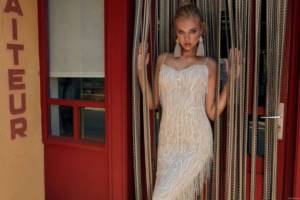
Photo courtesy of the Valencia wedding salon
If you try to describe in one word what kind of wedding attire is in fashion today, then it would probably be stylish. Considering the proportions of her body, a girl can try on the clothes of any era without fear of appearing out of date. There are no outdated styles! You need to be wary of stylistic errors associated with the combinatorics of individual elements and violation of the integrity of the image. It doesn’t matter what you choose - audacity or romance, brevity or brilliance, restraint or a fountain of emotions, the main thing is to stay in the role until the end.
Photos courtesy of the Valencia wedding salon
Try on not a dress, but an era. Try to mentally, at least for a moment, wake up in the time where your soul is striving. The heart will gratefully tell you which dress to choose. Keep this magical feeling of the image throughout the holiday. You will be irresistible.
Photos courtesy of the Valencia wedding salon
A girl from the times “present + future” is active, confident in her abilities, fit and knows exactly what she wants from life. Go for it!
History of wedding dresses
Every girl dreams that one day she will walk down the aisle in a luxurious wedding dress. And in old photographs you can see the wedding dresses of not only our mothers, but also our grandmothers. And someone, perhaps, still has their grandmother’s wedding dress in their house, which you can touch. What is the history of wedding dresses? What wedding dresses did our distant great-great-great and many more great-grandmothers who lived in the Middle Ages wear? What kind of wedding dresses did ancient Greek girls get married in?
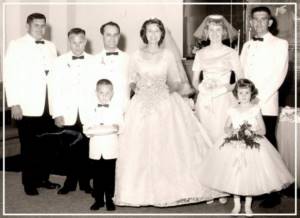
The history of wedding dresses - the ancient world. In Ancient Egypt, girls wore kalaziris to weddings. This outfit was a piece of material that wrapped the figure from the chest to the ankles, with one or two straps. The main role was played by jewelry: ankle and hand bracelets, magic amulets, rings, beads, belts.
In Ancient Greece, the bride's outfit consisted of a piece of long fabric that was wrapped around the body, with two clasps; the more noble the bride's family, the more luxurious these clasps were. The bride's head was covered with a yellow cape, which symbolized the sun and happiness.
In Ancient Rome, brides wore a scarlet veil on their heads, against which their skin looked pale and marbled, like Roman statues, and the color itself symbolized the passion, love and innocence of the bride.
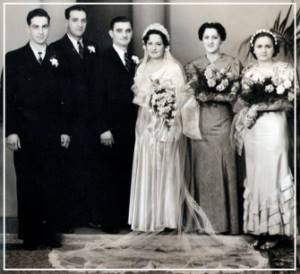
History of wedding dresses – Russia. In Russia, during the times of Kievan Rus, brides dressed up in long white shirts with wide sleeves and red sundresses, the same color, red, which symbolized happiness, joy and beauty, ribbons were woven into their braids, and a soul warmer was put on top. After the wedding, the braids were wrapped around the head, which indicated a change in the girl’s status from a bride to a married woman. Aristocrats wore a cloak-robe with gold embroidery over their sundress, and their heads were adorned with a crown-hoop with jingling pendants. And only starting from the 18th century, Russian brides began to follow European fashion, as Peter I issued a decree in this regard.
As a matter of fact, wedding dresses were never just wedding dresses, they could easily be worn after the wedding, and white color was not used at weddings for many centuries; brides, both in Europe and in Rus', preferred dresses in red, orange and yellow colors.
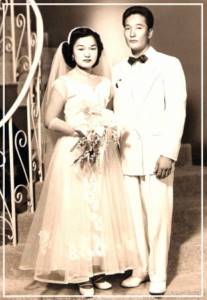
The first mention of a wedding dress, which was supposed to be worn specifically for a wedding, dates back to the 15th century. It was a dress with a corset, high waist, V-neck, long sleeves. At that time, the state of being “a little pregnant” was in fashion and girls had special pillows that were placed on the stomach under many dresses, including wedding ones. On the bride's head they wore a high pyramid-shaped headdress - enen, which was decorated with a veil made of silk. And in order to keep such a large hat on their head, brides were forced to walk with their heads down. The colors of the dresses were still red, scarlet and purple.
For the first time, Queen Marguerite of Valois, Queen Margot, decided to wear a white wedding dress. Before this, it was believed that white was the color only of the brides of Christ. The girls followed her fashion, but widows, when getting married for the second time, did not have the right to dress up in white; they wore black dresses with red inserts.
During the Renaissance, wedding dresses were made from white satin or silver brocade, embroidered with precious stones and pearls. The bride's pearls were also woven into her hair.
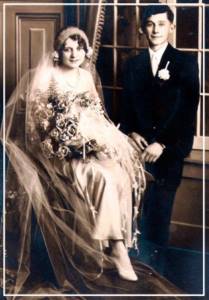
In the Baroque era, plumpness came into fashion, as did dresses with full skirts and sleeves. At this time, wedding dresses were mostly golden, or yellow and green. By the way, wedding dresses in Ireland used to be mostly green. Also, in the Baroque era, wedding dresses began to be decorated with lace for the first time, and then it would be very difficult to imagine a wedding dress without them. Pearls were used for decoration. At the beginning of the 17th century, for greater pomp, they wore at least three petticoats, as well as stockings, always with lush bows and flirty ties. By the end of the century, pink and coral colors for wedding dresses came into fashion.
In the 18th century, the Medici collar (a fan-shaped lace collar) came into fashion and dresses also began to be decorated with embroidery and gold. Pastel colors are in fashion: light blue, soft pink. And commoner girls often got married in gray dresses.
In the Rococo era, wedding dresses were mainly in silver tones, always with a train, the length of which determined the status of the bride, and lush and complex hairstyles and wigs came into fashion.
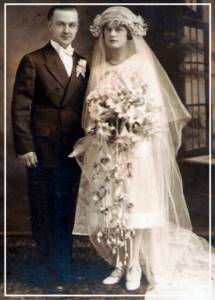
During the neoclassical era, light-colored dresses were in fashion, and in the 1790s, white wedding dresses came into fashion. By the way, even before this time, Anne of Austria, Mary Stuart and Margaret of Valois, whom we have already mentioned, had white wedding dresses.
At this time, white wedding dresses, as we remember, were in fashion with a high waist and short puffed sleeves, and the bride’s head was decorated with a headdress made of artificially created orange flowers - “fleur d’orange”.
But soon fluffy skirts and decorations made of ruffles and lace are back in fashion. In the 20-30s of the 19th century, wedding dresses were bell-shaped. In the 30s, the bride's head was again decorated with a wreath of orange flowers made of silk, cotton wool and velvet, and the sleeves of the dress were trimmed with flower branches. In the 50s of the 19th century, wedding fashion included jewelry, except diamonds, and gloves. The French Empress Eugenie introduced Brussels lace into fashion. She got married in a dress made entirely of lace. By the 90s, the skirts of wedding dresses became narrower, and the sleeves, on the contrary, became even wider.
In the 1900s, wedding dresses became more closed - stand-up collars appeared, and skirts were slightly shortened, now they barely covered the ankles, and corsets went out of fashion.
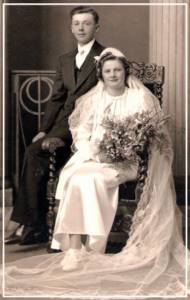
And then the fashion for wedding dresses changes at the speed of light, or even faster. After the First World War, the wedding bouquet appears. Coco Chanel offers a bold wedding dress with a short knee-length skirt and a long train at the back. In the 30s of the 20th century, lush wedding dresses were again in fashion, often with a corset and a jacket. In the 50s, thanks to Dior, full skirts of wedding dresses were again in fashion. And the 60s is the era of minimalism and short skirts. In the 80s, the fashion for long romantic wedding dresses with ruffles and embroidery returned.
Well, today a bride can afford any version of a wedding dress, any colors and any length, based only on her own idea of what exactly her ideal wedding dress should look like.
Modern trends in wedding fashion
Today we boldly talk about the existence of a highly profitable wedding dress industry. Perhaps it is not developing as dynamically and dramatically as other industries, but there is a completely reasonable explanation for this - firmly entrenched traditions as opposed to new ideas. Creators of wedding dresses have to take them into account.
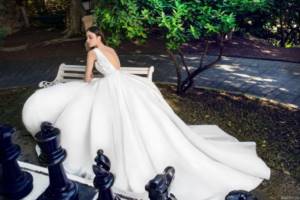
Photo courtesy of the Valencia wedding salon
But still, if you analyze the “long journey of the dress to the bride,” you cannot help but notice the refreshing breath of the 21st century:
- In a new round, royal luxury and sophistication have returned to wedding dresses.
- Modern textile technologies have revealed to the world fabrics that are impeccable in texture and workmanship, satin, silk, lace, with which you can build a silhouette, create thick draperies, and create decorative details. These materials combine presentability and practicality, maintaining their original appearance even on the most active bride.
- The bride's possibilities are limited only financially; otherwise, you can experiment endlessly, choosing a style, material, color, and finish.
- Wedding dresses are created in a minimum edition, sometimes in a single copy, and are combined into small seasonal collections, replenished several times a year. Salons are interested in a wide range of buyers, including pregnant brides and those with special needs. Visual monitoring shows that there is an ideal choice for any female figure.
Recently, stylists have been offering long silhouettes that maximally emphasize the waist and reveal the shoulders and arms.
Photos courtesy of the Valencia wedding salon
Some specifics using the example of dresses from the Valencia wedding salon (the most popular styles for girls of different sizes):
- ball gowns – “Lanesta Amandola”, “Lussano Bridal Davina”, “Lanesta Lumia”, “Farletta Petuniya”, “Naviblue Bridal Linda”, “Farletta Sagitta”, “Preciosa” (by Natalya Romanova), “Magdalena” (by Eva Utkin), “Blanch” (author Anna Kuznetsova);
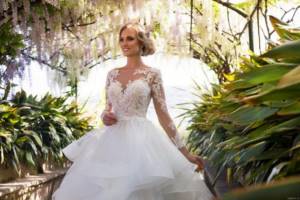
Photo courtesy of the Valencia wedding salon
- mermaid dresses – “Lanesta Emily”, “Lanesta Makko”, “Farletta Cassiopeia”, “Star” (a signature feature from Anna Kuznetsova);
Photos courtesy of the Valencia wedding salon
- A-line dresses in the style of the 60s - “Gabbiano Cessa”, “Obstinate Chamomile”, “Farletta Franjepani”, “Dorotea” (by Anna Kuznetsova), “Batri” and “Freya” (by Natalya Romanova);
Photos courtesy of the Valencia wedding salon
- dresses in the Greek Empire style – Gabbiano “Colombina” and “Estel” Ariamo “Lucca”, Oksana Mukha “Ennis”;
Photos courtesy of the Valencia wedding salon
There are many interesting trends at stake for the 2018-2019 season:
- high collar;
- delicate pastel;
- deep cut;
Photos courtesy of the Valencia wedding salon
- floral-themed appliqués and embroideries;
- short skirts with trains;
- bare shoulders;
- long, narrow or widened sleeves;
Photos courtesy of the Valencia wedding salon
- bold violations of color balance - the most unexpected shades and their combinations in cut or in contrasting finishes;
- lace appliques with tattoo effect;
- original sleeveless raincoats (capes) or capes instead of a veil or headdress;
- crop top style.
What types of wedding dresses are there?
Here are the key features of the bride's outfit:
- Style . This could be an outfit in the styles “boho”, “vintage”, classic”, “hipsters”, “ombre”, “shabby chic”. Among pregnant girls, Greek-style models are extremely popular.
- Length . The most common option is floor-length, ankle-length, knee-length and short. There are three types of length: mini, midi and maxi. The first is suitable for girls with perfectly straight legs, the second for tall ones, and the last for those who want to hide imperfections in the lower body (wide hips or full legs). An excellent alternative to this look would be a dress that is short in the front and long in the back. This style is usually called a “transformer”.
- Form . As a classic example, we can offer the “princess” model, which is characterized by a narrow top and a bottom flared to the floor. An equally interesting cut is straight. It suits almost all girls. As for the bodice, it can be in the form of a corsage (heart), with open shoulders, with lowered straps, or with straps over one shoulder.
- Types of cut . The name of the most famous is “imperial”. This model has a wide, loose skirt that starts at the chest and gracefully falls to the floor. If it has sleeves, they are almost always made like bells. Another option is “column”. The hem of the dress rises 2-4 cm above the floor, slightly exposing the legs. The top is open, perhaps even without straps. The skirt hugs the lower part of the body and mercilessly reveals all its flaws.
- What does it consist of ? A wedding dress includes several parts - a bodice and a skirt (can be separate), sometimes a corset and a train. The latter can be removable or permanent.
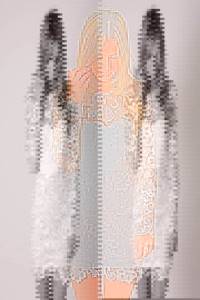
Mini length
